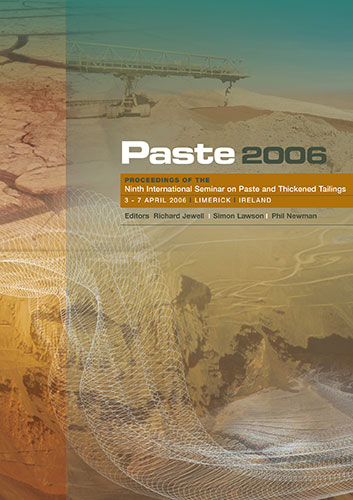Liquefaction Potential of Surface Deposits of High-Density Thickened Tailings

|
Authors: Fourie, AB |
DOI https://doi.org/10.36487/ACG_repo/663_10
Cite As:
Fourie, AB 2006, 'Liquefaction Potential of Surface Deposits of High-Density Thickened Tailings', in R Jewell, S Lawson & P Newman (eds), Paste 2006: Proceedings of the Ninth International Seminar on Paste and Thickened Tailings, Australian Centre for Geomechanics, Perth, pp. 107-116, https://doi.org/10.36487/ACG_repo/663_10
Abstract:
One of the major perceived benefits of using high density thickened tailings for the surface disposal of mine wastes is the reduced risk of catastrophic failure. Utilisation of the procedure is, however, relatively new and there are few well-established operations from which field experiences can be gained. Concerns of potential liquefaction as a consequence of seismic activity are discussed in this paper and techniques for evaluating the potential for liquefaction derived from experience with natural soil deposits described. An inescapable conclusion is that although the likelihood of liquefaction failures in thickened tailings deposits are extremely low, care must be taken in utilising existing techniques that were derived from field data obtained from material that differs significantly in behaviour from that of thickened tailings.
References:
Barrera, S. (2005) Aspects to be considered in dynamic stability analysis. Proceedings of the 8th International Seminar on Paste and
Thickened Tailings, April 2005, Santiago, Chile, Vol 2, pp. 67-84.
Paste2006,Limerick,Ireland 115
surfAce disPosAl
Bjelkevik, A. (2005) Swedish tailings dams incidents and failures-Lessons learnt. Proceeding of Conference on Securing the Future,
June 2005, Sweden, pp. 12.
Blight, G.E. (1997) Destructive mudflows as a consequence of tailings dyke failures. Proceedings Civil Engineers Geotechnical
Engineering, Vol.125, pp. 9-18.
Blight, G.E. and Fourie, A.B. (2005) Catastrophe revisited – disastrous flow failures of mine and municipal solid waste. Geotechnical
and Geological Engineering, 23(3), pp. 219-248.
ICOLD (2001) Tailings dams – risks of dangerous occurrences: lessons learnt from practical experiences, Bulletin 121, International
Committee on Large Dams, UNEP, Paris.
Ishihara, K. (1993) Liquefaction and flow failure during earthquakes, thirty-third Rankine Lecture, Geotechnique, 43, pp. 349-416.
Morales, J.E. (2005) Tailings paste application in the Chilean mining industry. Proceedings of the 8th International Seminar on Paste
and Thickened Tailings, April 2005, Santiago, Chile, Vol 2, pp. 5-8.
Pirouz, B., Kavianpour, M.R. and Williams, P. (2005) Thickened tailings beach deposition. Field observations and full-scale flume
testing. Proceedings of the 8th International Seminar on Paste and Thickened Tailings, April 2005, Santiago, Chile, Vol.1, pp.
53-72.
Shuttleworth, J.A., Thomson, B.J. and Water, J.A. (2005) Surface paste disposal at Bulyanhulu – Practical lessons learned.
Proceedings of the 8th International Seminar on Paste and Thickened Tailings, April 2005, Santiago, Chile, Vol.1, pp. 207-218.
Seed, H.B. and Idriss, I.M. (1982) Ground motions and soil liquefaction during earthquakes. Earthquake Engineering Research
Institute Monograph, Oakland, California.
Seed, H.B., Tokimatsu, K., Harder, L.F. and Chung, R.M. (1985) The influence of SPT procedures in soil liquefaction resistance
evaluations. Journal Geotechnical Engineering, ASCE 111(12), pp. 1425-1445.
Vietti, A. and Dunn, F. (2001) Co-disposal at De Beers diamond mines. Proceedings of International Seminar on Paste and
Thickened Tailings, May 2001, Pilanesberg, South Africa, pp. 16.
Wagener, F. (1997) The Merriespruit slimes dam failure: Overview and lessons learnt. Journal of the South African Institution of
Civil Engineering, 39(3): pp. 11-15.
Williams, P. (2000) Proceedings of International Seminar on the production and disposal of thickened paste tailings for mine backfill
or on the surface. Australian Centre for Geomechanics, April 2000, pp. 10.
116 Paste2006,Limerick,Ireland
LiquefactionPotentialofSurfaceDepositsofHigh-DensityThickenedTailings A.B.Fourie
© Copyright 2026, Australian Centre for Geomechanics (ACG), The University of Western Australia. All rights reserved.
View copyright/legal information
Please direct any queries or error reports to repository-acg@uwa.edu.au
View copyright/legal information
Please direct any queries or error reports to repository-acg@uwa.edu.au